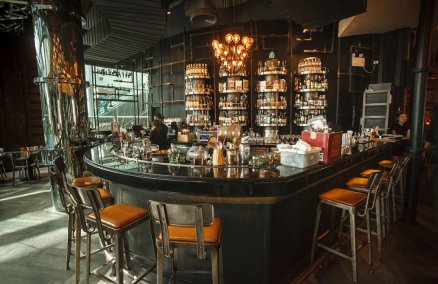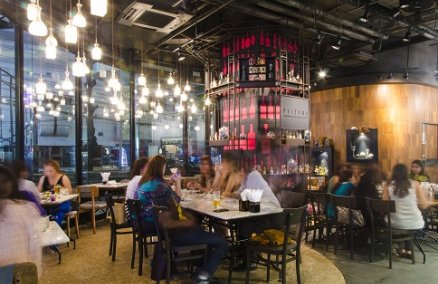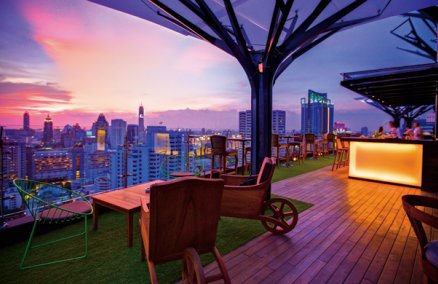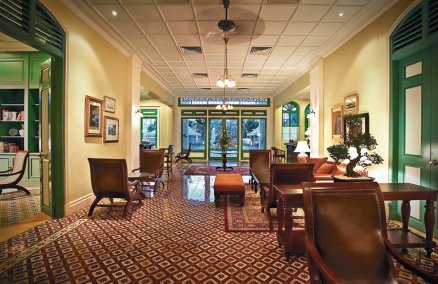It’s nearly impossible to get a protest off the ground these days. Civil Society Organisations (CSOs) are not allowed to protest outdoors in Singapore at the IMF/World Bank Annual Meetings, and after having set up an alternative forum and public protest in Batam they’ve been told at the eleventh hour by local Batam police that these events might not happen.
Every third year, the international financial institutions International Monetary Fund (IMF) and World Bank hold their Annual Meetings outside Washington D.C. Attending these meetings are the governors and shareholders of these institutions—more than 300 finance ministers from 184 member countries. Civil Society Organisations, or CSOs—comprising non-governmental organizations (NGOs), faith-based organizations, labor unions, community groups and research centers—have a forum at which they air their issues and meet with the governors and shareholders, and, traditionally, also stage public demonstrations to raise awareness for their campaigns. This year’s CSO forum is on Sep 14-20, in Suntec Singapore International Convention and Exhibition Centre, alongside the official meetings and seminars also taking place there.
The last IMF/World Bank meetings outside D.C., in 2003, were held in Dubai, a country with laws on civil activity as strict as Singapore’s. The choice of Dubai—and now Singapore—marks a trend for the IMF/World Bank to hold their meetings in countries where public demonstrations are prohibited, press freedom restricted and CSO presence and activity limited. At Dubai there was absolutely no public protest at all—the Dubai authorities told IMF/World Bank meeting attendees that anyone thinking of demonstrating would have to do so indoors and erected a tent (an air-conditioned one!) for that purpose (no one used it). The Singapore authorities are taking a similar stand by restricting protests to the lobby of the Suntec Convention Centre.
Not to be silenced, a large group of CSOs have organized a parallel forum in Batam, the International People’s Forum (IPF), on Sep 15-17, with a public protest planned for Sep 18. The driver behind this is a large group of conveners and sponsor Jubilee South, or the Asia Pacific Movement for Debt and Development, an NGO that deals with debt relief and cancellation in Southern countries, and which works against the IMF/World Bank bias towards big corporations and wealthier countries.
The number of CSOs attending either forum is yet to be confirmed, but World Bank representatives in Singapore have said that about 400 CSOs have applied—a record number. Batam also boasts an impressive list of conveners, including Action Aid International, Friends of the Earth, and Greenpeace, among the better known ones; it expects to draw between 600 and 900 people. The World Bank says that—if they are invited—they will attend the Batam meetings. Last weekend, however, it was reported that Batam local police are trying to block the forum and protest. Nevertheless, the organizers of the IPF are pushing ahead. Dian Kartika, the deputy executive director of INFID (International NGO Forum on Indonesian Development), the Indonesian convener of the IPF, says, “Under Indonesian law we are not obliged to get permission from the police to protest but only to inform them about a protest. The police in turn are obliged to provide security to ensure that there are no riots or violence. We sent the Batam police our information on Aug 1 and did not hear back from them till Aug 28 when they suddenly told us to stop the protest. We are trying to persuade them to cooperate with us but even if we can’t, we won’t cancel, we will go ahead, everything is prepared.”
We look at how CSOs feel about the split and what they are expecting to get from the forums.
"Under Indonesian law we are not obliged to get permission from the police to protest but only to inform them about a protest. The police in turn are obliged to provide security to ensure that there are no riots or violence. We sent the Batam police our information on Aug 1 and did not hear back from them till Aug 28 when they suddenly told us to stop the protest. We are trying to persuade them to cooperate with us but even if we can’t, we won’t cancel, we will go ahead, everything is prepared."—INFID, IPF Convener
Behind Closed Doors
As ironic as this may sound, there is a feeling among CSOs that the IMF and World Bank are actually becoming more responsive to them, and including them more in the Annual Meetings and paying attention to what they are saying. However, the IMF/World Bank’s decision to hold the meetings first in Dubai and now Singapore has not been lost on CSOs, and there is a counter opinion that while the IMF/World Bank are engaging CSOs more on the inside, they simultaneously want to silence them on the outside.
Aldo Caliari, director of Center of Concern, a faith-based organization promoting global justice and peace, who will have a representative at the Singapore meetings, says, “Increasingly, the IMF/World Bank are showing a friendly face to NGOs. The staff of these institutions want NGOs on the inside rather than on the outside, but this also makes NGOs less vocal. There is definitely a trend for the IMF/World Bank to hold their meetings in places outside the reach of NGOs.” Director in Washington for the World Confederation of Labor, an international network of workers’ unions, Paul Tennassee, agrees: “The IMF/World Bank have amplified dialogue with civil society but clamped down in other areas. Public demonstrations worry IMF officials because this is liberal democracy at work, and the officials are sensitive to what the masses are saying.”
Sophie Richardson, deputy director of the Asia Division of Human Rights Watch, has a much less comprising view. She asserts, “It is important for CSOs to demonstrate peacefully. The issues discussed at the IMF/World Bank Annual Meetings are ones that profoundly affect people’s lives, and these institutions are much less vulnerable to public scrutiny—and of course can’t be voted out of office—than an individual government. This reality means that it is all the more—not less—important for individuals and groups to voice their views. If the IMF/World Bank officials responsible for making the decision to hold the meetings in Singapore thought that either it simply would not be an issue, or that exceptions allowing protests would be made, they are either remarkably poorly informed or naïve...If the IMF/World Bank were genuinely concerned about ensuring free speech around their meetings they should have asked publicly for the Singaporean government to commit to allowing peaceful demonstrations, and, had the government refused, moved the meetings elsewhere."
The World Bank insists, however, that there is no political agenda behind their choice of Dubai and Singapore as locations for their Annual Meetings. Media and Outreach Coordinator Arin Basu says, “People read too much into this. Our reasons for choosing a location for the Meetings are surprisingly mundane. We see which countries bid to hold the Meetings and look at their capacity to handle the Meetings, which includes things like the number of hotels, the size of their convention centre, their airport and roads. In the case of the 2006 Meetings, Singapore won the bid because—no other country applied. We think that this is because, post 9/11, countries were reluctant to take the security risk that comes with holding a big international meeting.”
The Singapore government reinforces this stance. In a press statement, the Singapore Police Force says “The police recognize the importance of the participation of CSOs in the event. We have made maximum effort to facilitate their involvement within the framework of our laws. However, we are unable to waive the current rules which prohibit outdoor demonstrations and processions, so as not to compromise security."
"If the IMF/World Bank were genuinely concerned about ensuring free speech around their meetings they should have asked publicly for the Singaporean government to commit to allowing peaceful demonstrations, and, had the government refused, moved the meetings elsewhere."—HUMAN RIGHTS WATCH
Two Sides of the Same Coin
Even though some CSOs feel it is a shame that their discussions will be split between two forums, they also acknowledge having a parallel forum to Singapore’s is better than having no alternative at all—like in Dubai—and that each forum has a helpful role to play. In Singapore, CSOs have a rare opportunity to gain access to and form strategic alliances with finance ministers, whereas in Batam they will be dealing more with colleagues who work in the same field.
Peter Bosshard, the Policy Director of the International Rivers Network that fights for fair and sustainable water and energy management, hopes to attend both the Singapore and Batam meetings and has this to say: “For better or for worse, World Bank meetings turn into a bit of a jamboree of governments, bureaucrats and activists. NGOs who want decision makers will go to Singapore; activists will go to Batam. I sense that in Southeast Asia, NGOs are really mobilizing, but we will probably see this more in Batam than in Singapore.”
Caliari of Center of Concern agrees, “Both Batam and Singapore are important. In Batam we can network with colleagues, catch up, whereas in Singapore we can establish contact with finance ministers and find common ground with them.” However, he speculates that—in spite of the World Bank’s numbers—more NGOs will choose going to Batam over coming to Singapore. With such optimism for the Batam forum, many would obviously like to see it go ahead.
On the Agenda
As the Meetings draw close, attention is turning to some of the key socio-economic issues CSOs are bringing to the table. On a broad level, the Meetings will cover trade, finance, energy, corruption, debt, and the environment, to name but a few issues. For example, in the clean energy and development field, a coalition of NGOs, including the International Rivers Network (IRN), the Bank Information Center, Friends of the Earth and the Institute for Policy Study, will be pushing for more World Bank funding for renewable energy projects.
A number of CSOs will also be taking the World Bank to task on its work to clean up corruption. The IRN, for instance, wants the World Bank to strengthen its anti-corruption framework which it claims currently “skirts the issues of corruption in development finance.” Bosshard of IRN explains, “Corruption not only plunders, but shapes economies. Corruption is not a matter of individual contracts; it distorts an entire development project, as officials know which international corporations pay generous bribes [and give repeat business to those corporations]. Fighting corruption at the level of individual projects and contracts will remain a losing battle unless the World Bank addresses the systematic mechanisms of corruption.”
"People read too much into this. Our reasons for choosing a location for the Meetings are surprisingly mundane. We see which countries bid to hold the Meetings and look at their capacity to handle the Meetings...Singapore won the bid because—no other country applied."—THE WORLD BANK
Another key issue is the voice that developing countries have in the decision-making process of the IMF and World Bank. According to Caliari of Center of Concern, while developing countries now have a much bigger voice in the IMF and World Bank than just a few years ago, the IMF/World Bank voting system needs further reform to involve these countries in decision-making. The World Confederation of Labor will also be pushing for democratization of the board of IMF as well as raising WCL’s agenda of dealing with labor standards, tensions, social security, sustainable development and debt.
The full range of issues that will be covered by the IMF/World Bank and the CSOs is far greater in scope and depth than what we have mentioned here, of course, which is just the tip of the iceberg. The CSO talks in Singapore will involve some 30 policy dialogue sessions between IMF and World Bank staff, CSO representatives, government officials, donor agency officers and academics; launches of key reports by Oxfam, the Global Campaign for Education, Friends of the Earth and the IRN; and personal meetings with World Bank and IMF senior managers. In Batam, participants of the People’s Forum can expect three days of plenary sessions involving presentations from international speakers and open discussions, seminars, workshops, meetings, and exhibitions.
Banging the Drum
If all these issues are getting the attention they merit, then, one can ask, does it matter that CSOs are not allowed to demonstrate in Singapore? After all, the important thing is that these issues get dealt with, not how much noise is made in public about them—which is, in a way, what protests are.
According to Human Rights Watch’s Richardson, it matters a lot. The issue at hand is a fundamental one. “The right to free assembly, association and expression are among the most basic values of the Universal Declaration of Human Rights, and core principles of most binding human rights instruments, such as the ICCPR (International Covenant on Civil and Political Rights). Without these rights, individuals or organizations are unable to challenge authoritarian regimes, ensure humane treatment or engage in political debate,” she states.
But do demonstrations actually help effect change or are they just a song and dance? Tennassee of the World Confederation of Labor has an interesting view. He feels that while demonstrations can be effective, in the case of the IMF/World Bank, CSOs are better off campaigning outside the offices of the G7 countries in Washington than at the Annual Meetings outside of D.C. For Center of Concern’s Caliari and others, however, there is something to be gained from demonstrating at these meetings. “Demonstrating in public actually puts pressure on institutions to reform,” Caliari says. “Something that lobbying inside a building alone cannot achieve.” IRN’s Bosshard is optimistic about the positive effect of demonstrations, saying that they have helped strengthen his cause immensely by putting “big projects such as mines more in the public consciousness.” He also attributes the successful reduction of the rate at which new dams are built to the growth in civil society’s voice in the last 10-15 years, a hopeful sign that pressure from CSOs—that involves public protest and demonstration—produces concrete results. Caliari points out that CSO activity has been fruitful in the area of debt relief, and has made total debt cancellation a reality for some countries which would not have been an option in the past.
World Vision, a faith-based organization whose mission is to help children and families, and which has been in Singapore for over 20 years, will be present at the Singapore meetings and is considering also attending the Batam forum. Their representative this year, Director of Regional Advocacy and Child Protection Laurence Gray, has a balanced approached towards public demonstrations. He is pragmatically happy to “work within the local context and do what’s appropriate.” In other words, while Gray acknowledges that public demonstrations are an effective means of communication, there are other mechanisms a group can use to get its message across that are just as effective, such as press releases and lobbying. The trick, in his opinion, is to find the right mechanism for the situation in which one is working.
Bosshard sums it up well. He feels that while it is perfectly legitimate for Singapore to expect CSOs coming to town for the meetings to behave like guests, in return, CSOs “should also be treated like guests.” This means allowing them to conduct their activities freely, openly and without suspicion, which includes the opportunity to demonstrate peacefully in public. With restrictions in Singapore and NGOs having to negotiate hard with the Batam authorities to protest peacefully there, it seems Southeast Asia is not ready for the full impact of a meeting like this. But Bosshard hopes—as many do—that such civil liberties will be allowed in time.



























